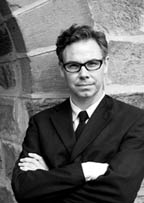
 March
12, 2003:
President's
Page
March
12, 2003:
President's
Page
Last fall Stan Allen *88 (pictured at right) became dean of our School of Architecture. A founding principal and director of the interdisciplinary design practice Field Operations, Dean Allen taught at the Columbia University Graduate School of Architecture for over a decade. I thought you would enjoy hearing from him.
Architecture is first of all a public art form, and I feel fortunate to have come to the School of Architecture at a time of increasing awareness of the importance of design. The discussions around the rebuilding of the World Trade Center have offered rare insight into architectural practice and its relationship to the public realm. In June of last year, public outcry over the lackluster planning proposals released by the Lower Manhattan Development Corporation prompted that agency to release a second call for innovative design proposals. The nine projects released last December (with substantial Princeton faculty and alumni participation) answered that call forcefully and re-established the importance of an imaginative architectural vision in the complex process of rebuilding the city. Architecture has become a subject of passionate public debate, and the pressure on the profession to rise to the occasion has never been greater.
The next step in Lower Manhattan will be a lengthy process of study, adjustment to technical and economic constraints, and negotiation among the multiple stakeholders. Architecture demands patience and sustained creativity over a long period of implementation. This delicate balance of experimentation, rigorous testing, and intricate negotiation is fundamental to architectural education. Every architect must be, to some degree, a generalist. As a small professional school within a major university, Princeton’s School of Architecture is well positioned to train architects for these complex tasks. Our own faculty offer a rich mix of design, scholarship, and technical expertise. Interdisciplinary collaboration with the Woodrow Wilson School exposes our students to policy issues, while our relationship to the School of Engineering gives us access to a first-rate engineering faculty.
Increasingly, the practice of architecture unfolds on a global stage. Architects from London, Berlin, Tokyo, New York, Los Angeles, and Rotterdam contributed to the World Trade Center proposals. We prepare our students for this new reality of global practice with an active program of international exchanges. Our students will travel this year to China, Singapore, and India. In the spring semester, we will host students from London, Barcelona, and Paris as part of a studio exchange jointly sponsored by the U.S. Department of State and the European Union.
Princeton is unique among schools of architecture for its small size, which allows close contact between students and faculty, and for the close relationship among its three programs (undergraduate, professional master’s, and Ph.D.). Undergraduate architecture concentrators share classes, faculty, and studio space with graduate professional students, while the presence of Ph.D. students brings an exceptional level of intellectual seriousness to the study of architecture at Princeton. The common thread among these programs is the idea of architecture as a cultural practice; that is to say, of architecture as an art form capable of contributing to public discourse.
The recent professional and scholarly activities of our faculty confirm this. Professor Elizabeth Diller, who, with her partner Ric Scofidio, received the first MacArthur Fellowship ever awarded in architecture, recently completed an innovative exhibition structure in Neuchatel, Switzerland. The “Blur Building” created an ephemeral environment of water mist, supported by a highly engineered steel platform. A survey of the work of Diller+Scofidio opened at the Whitney Museum of American Art on March 1.
Visiting Professor Peter Eisenman recently won the competition for a “City of Culture” in Santiago de Compostela, in the Spanish province of Galicia. His radical proposition, which houses a complex mix of cultural and artistic facilities below a sculpted roofscape of artificial terrain, is currently under construction.
A recent article in the New York Times identified Associate Professor Guy Nordenson as one of a select group of structural engineers recognized internationally for their creativity and design abilities. Nordenson’s innovative structural solutions have made him a favored consultant among high-design architects. Recently completed projects include an award-winning dormitory at MIT designed by architect Steven Holl. Nordenson frequently collaborates with visiting design critics Stephen Cassell ’86 and Adam Yarinsky *87 of the Architecture Research Office in New York. A monograph documenting their work will appear this spring, under the imprint of Princeton Architectural Press, the well-known architectural publishing house founded by Kevin Lippert ’80, *83. The press also will publish Cold War/Hot Houses, a collection of essays by School of Architecture Ph.D. students edited by Professor Beatriz Colomina.
In the area of urban design, a team of students led by Professor Mario Gandelsonas and former Dean of the School of Architecture Robert Geddes, along with teams from Harvard, Columbia, and City College, is completing a design study for the future of Midtown West in Manhattan.
The School of Architecture has been more active than ever before in
our dual roles of educating architects and addressing architecture’s
role in society. Design innovation, urbanism, and the integration of new
technologies will be the priorities at the school in the coming years.
To accomplish these goals, we will recruit new faculty and initiate new
programs. However, the commitment to public discourse will remain primary.
Architecture has been welcomed into the public arena; as educators and
architects, it is now up to us.
![]()
